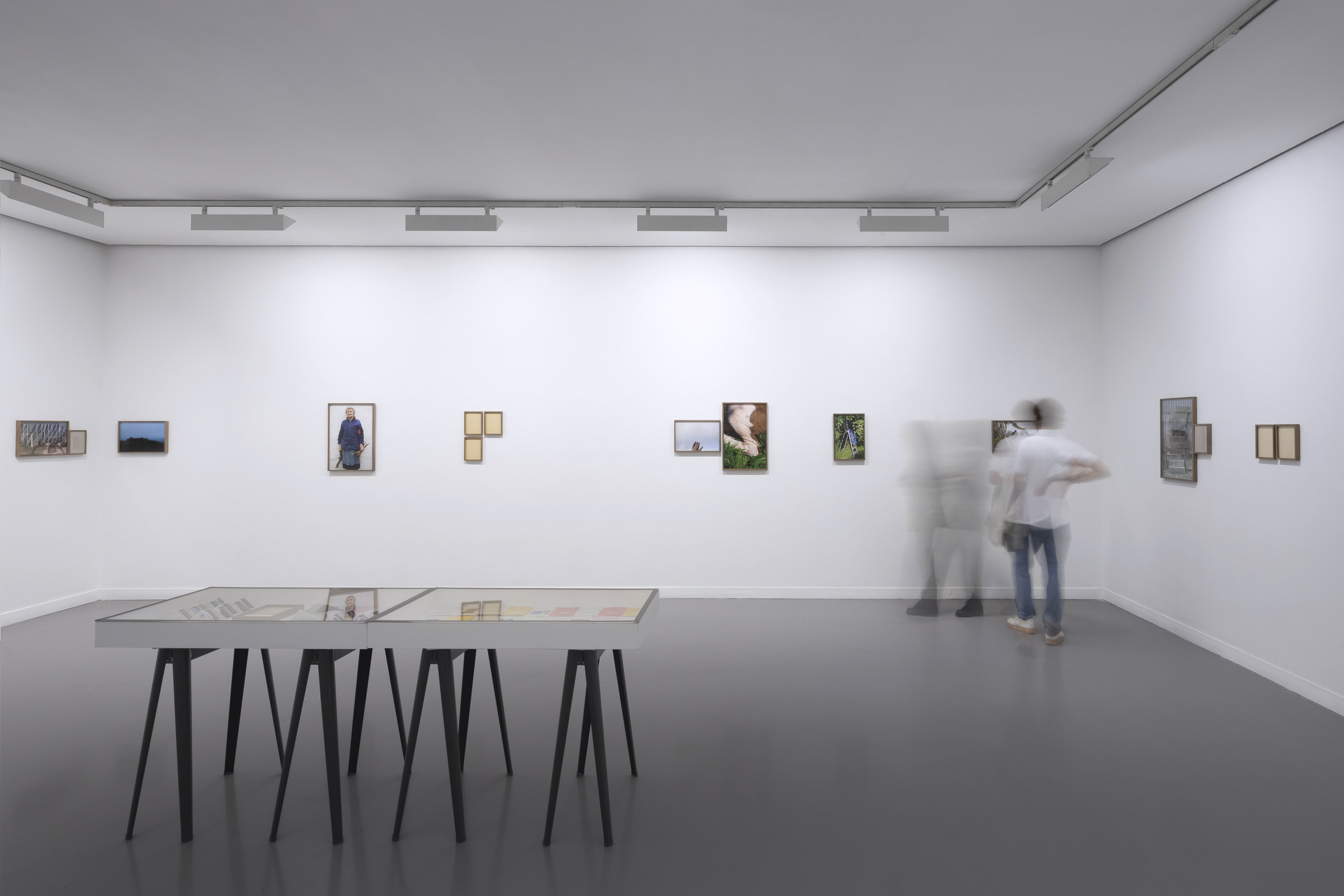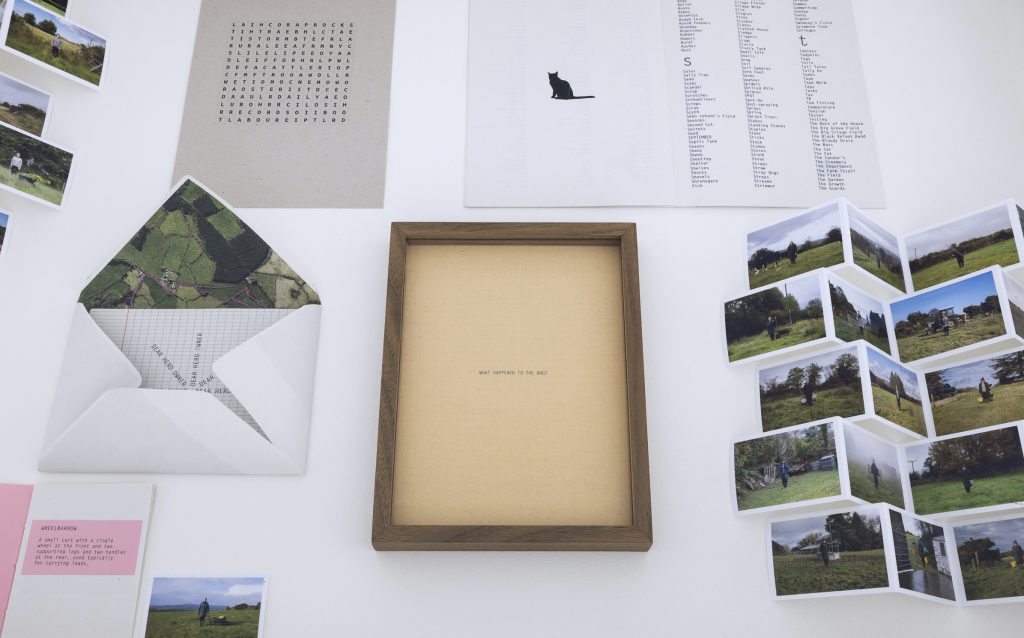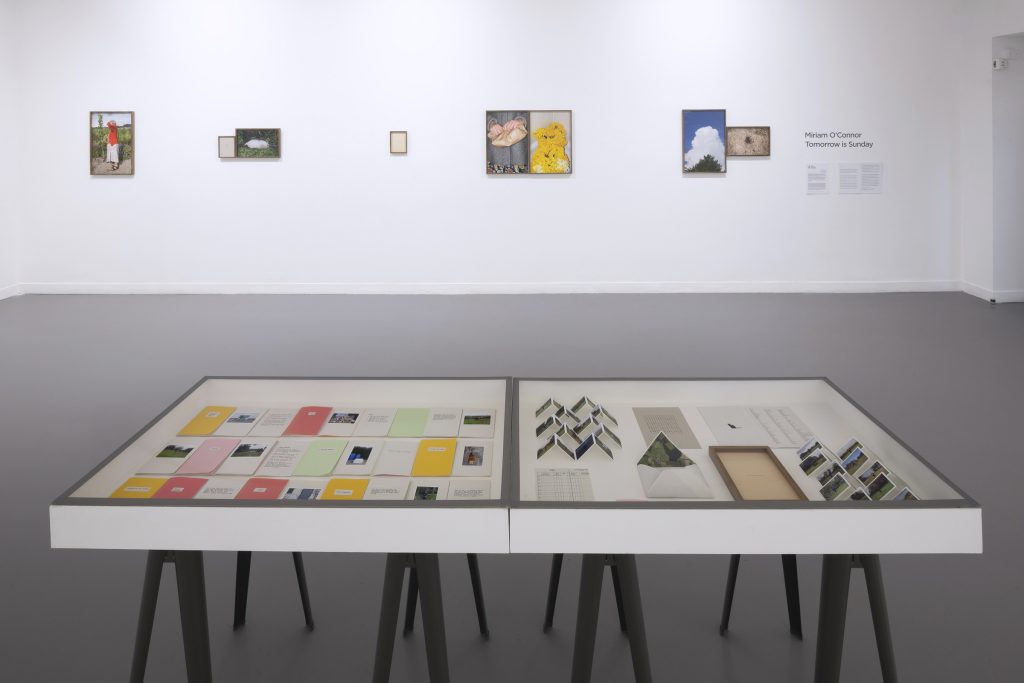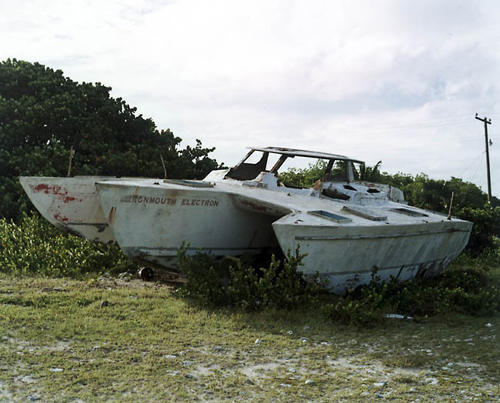In the beginning, her mother was against getting a cat. Spot, the family dog, had gone missing on 23 September 2010, and never came back. Miriam O’Connor took a photograph of the handwritten note about this and displayed it as part of her exhibition, Tomorrow Is Sunday. Her mother must have relented though, because there is another note on a torn piece of cardboard: The Cat ate his Lunch. Then he got sick and Vomited. He is asleep Now. I had to clean up. Mom. O’Connor put this note on display, too, and she dedicated the book that accompanied the exhibition to the precious farming cat. The cat is precious because the dog went missing and because O’Connor’s brother Jerome died, after which she came home to County Cork to be with her mother and sister. That was in 2013. The sun has risen and set. O’Connor helps on the family farm now, occupying the dual role of farmer and photographer. She photographed the plastic buckets of cow feed and Dulux paint that are kept and used for farmyard chores once they are empty. She photographed them one after the other, day after day, sometimes full, sometimes empty. She took photographs of rocks and stones in the locus of the farm, one after the other, day after day. In the book, she explains: ‘I surmised that if photography was going to make things better, or serve any function at all, then it had better be put to work.’
*
‘Friends die,’ said Mary Ruefle, ‘flowers come fast.’ Ruefle wrote this in response to Kathryn Scanlan’s Aug 9 – Fog (2019), a curated work of fiction based on the pages of a stranger’s diary the author acquired at an estate auction. The stranger was an eighty-six-year-old woman who lived in a town somewhere in Illinois. In her diary, which chronicles the years 1968 to 1972, she made notes about the weather, about the health of friends, about mealtimes and grocery shopping. Big snowflakes are like little parasols upside down. A friend comes to visit wearing her new red wig. Mildred burns her arm and Maude gets cancer. Tippy gets better and wants to go outside. Her son-in-law passes away. Friends die. Flowers come fast. I thought about Scanlan’s book when I walked around O’Connor’s exhibition, remembering how it had come to consume me as I was reading it a year or two ago, remembering how this document of the everyday felt like everything I needed to know, then and still. I thought about that book because O’Connor has been involved in her own form of diary keeping, her own depiction of everyday life that also feels like everything I need to know. She has made lists – of animals, of money owed and paid, of measurements taken. She has recorded incidents and information: ‘I got the vomiting bug’; ‘There are six miscellaneous gates on the farm’; ‘Very wet and cold today.’ For a long time, she and her sister had been keeping her mother’s handwritten notes. ‘When my brother died,’ she wrote, ‘we began to search through this archive, looking for traces of him.’
Installation views of Miriam O’Connor, Tomorrow Is Sunday, RHA, 2021
Photos: Kate-Bowe O’Brien
Has she found those traces in the notes she sifts through? Or are they there, instead, in the image she has taken of the rakes and the scythes lined against the wall? Or in the picture of the wheelbarrow, abandoned somewhere on the farm site with its load of shovels and sweeping brush? Maybe they are there in the push of white behind the tree, the cloud O’Connor has photographed in such a way that it looks as if it is rising rapid into the clear of the blue? I remember that article I read somewhere about Beckett grieving his father’s death, the way he told a friend he couldn’t write about it, this fresh and terrible absence, that he could only walk the fields and climb the ditches after his lost parent. Denise Riley, similarly unable to write, not for two years, following the sudden death of her adult son, explained that the act of describing would necessarily involve at least some notion of the passage of time, whereas Riley was stuck inside a condition of paralysed time. I wonder if photography, the immediacy of its capturing, can do what writing cannot, the way it maybe doesn’t have to struggle to get at those thoughts we all have, to catch them and trap them on the page?
*
But, no, it seems photography can drive a person crazy too. What is it O’Connor says again? ‘I resented it for making light of or romanticising such a tragic period in my life, in our lives.’
*
Now I’m turning the pages of O’Connor’s book, thinking once more about this phrase of hers, this notion of putting photography to work. For her, the concept means changing course, no longer marshalling her art form as consolation or escape, but using it instead together with routine farm tasks. She embarked on a series of self-portraits over an entire farming year. She compiled inventories of water troughs, fields, stakes, and gates. She made small logbooks that recorded in text and image the activities of the farm:
This job took a while as we needed to move the broken bath, shift the stones, consider ways in which to reassemble the wall, as well as reconnect the new water trough. The entire process took just under two hours on a Saturday afternoon.
Friends die. Flowers come fast. Denise Riley eventually wrote Time Lived, without Its Flow (2019), a book-length essay not about the death of her son, but about an ‘altered condition of life’, an attempt to convey an ‘extraordinary feeling of a-temporality’. The essay grimly observes time that is objectively passing – ‘Two weeks after the death’, ‘One month after the death’, ‘Six months after’ – while the writer, the bereaved mother, continues to exist in ‘a timeless present tense’, akin to a ‘stepping-outside the entire sheltering sky of temporality itself – into a not unpleasant state of tremendous simplicity, of easy candour and bright emptiness’. Maybe Riley is putting writing to work, trying to detail her experience of immobile non-time, explaining it as ‘a large pool’, a ‘great circle with no rim’. Riley becomes obsessed with her son’s autopsy report, a means of keeping her child company in his death. O’Connor became obsessed with a giant evergreen on the laneway that leads to the farm. She returned to it again and again, shooting it in sunlight, through fog, in the crawl of the evening light. She photographed it in snow, when it was raining; the tree all the while remaining, solid, unbending. ‘It was,’ she writes, ‘a place that I consistently returned to when I was trying to find my way.’
*
The women washing. The women scrubbing. The women peeling and preparing. O’Connor made her project with the financial support of A Woman’s Work, a 2018 European-wide programme aimed at representing women’s labour in all its forms. Other artists involved in the programme also put photography to work: Clare Gallagher, shooting images of the domestic, the hidden shift of housework and childcare made visible through her pictures of laundry piles and vegetable skins; Csilla Klenyánszki taking images of homemade sculptures hastily created during her infant son’s nap time, briefly transforming the family home into a studio, a fleeting grab at the person she once was. Some time ago, I acquired my grandmother’s letters, written in the final months of her life to her teenage daughter – my aunt – when her daughter was working as an English language-teaching assistant in the town of Gmunden, in Upper Austria. The letters, which begin on Sunday, 10 September 1972 and end on Saturday, 6 January 1973, not long before my fifty-nine-year-old grandmother’s last hospital visit, the one from which she never came home, are a study in the ordinary. My grandmother tells her daughter about the new carpet in the living room; tells her the dog was sick and they had to take him to the vet; tells her the cat will soon be having kittens.
I leafed through these letters, looking for the traces of the grandmother I never knew. Around the same time, I began watching the films of Chantal Akerman, so many of which reside in the drama of the interior, the minor sites of the kitchen, the bedroom, the thresholds, and passageways of small apartments. Akerman once said that all her movies were about her mother, and, even if they are not, they are certainly focused on spaces where women’s mundane lives are observed at length and in detail. She is probably best-known for her 1975 feature film, Jeanne Dielman, 23 Commerce Quay, 1080 Brussels, which examines a widowed mother’s regime of cooking, cleaning, and shopping over three days, and which features long, still shots of Jeanne scrubbing the bathtub, organising the bed sheets, peeling the potatoes for dinner, but even Akerman’s final movie, a documentary about her elderly mother who is now primarily confined to her apartment in Brussels, captures those same textures of daily life – the tea towel on the kitchen chair, the telephone on the hall table, the bed sheets drying on the small outside balcony – which continue to be almost never seen on film, which continue to almost never be seen as the stuff of art.

Installation views of Miriam O’Connor, Tomorrow Is Sunday, RHA, 2021
Photos: Kate-Bowe O’Brien
But friends die. Flowers come fast. ‘If you ever wondered what life was about, if you ever felt yours was not ‘exciting’ enough, then you should read this book,’ wrote Ruefle on the inside cover of Scanlan’s book. My grandmother’s letters, which tell me almost nothing of her inner thoughts and feelings, are nonetheless precious to me. O’Connor’s photographs of farm gates, of daffodils in the bathtub, her articulation in the logbooks of some of farming’s common problems – the difficulty of unrolling poly wire; losing the key to the tractor; forgetting to check the water pressure – feel so careful, deliberate, respectful. They are marking time. They are acknowledging space.
*
Denise Riley’s book ends with a postscript, which tries to explain what she has learned about living in arrested time. ‘How,’ she writes, ‘can I struggle to convey this distinctive experience of living inside a new non-time – while in the same breath I want to save it from being treated as unapproachable, and exceptional?’ For so long writing has not been serving her, in the way that photography did not serve O’Connor. Like me, Riley wonders about a different art form. Could cinema show it, she muses, this life of no time, not by means of any cinematic plot, but through the camerawork itself? But Riley is a writer, not a filmmaker; all she has is the blank page and what she can do with it now. And where she gets to with it – all this whirring on the page in the name of taking thought – is this: she gets to ‘an elaborate, dynamic, silent temporal abundance, even as this is also an abundance in loss’. I’m not sure if Riley’s notion of temporal abundance is the same, or similar, to Nabokov’s contemplation, in the novel Ada or Ardor, of true Time, which he says exists in the space between the beats of the other kind of time – ‘the gap between two such beats, the grey gap between black beats: the Tender Interval’, but it sounds as if it might be. It sounds about right, too, as a way I might begin to think about O’Connor’s photographs, her lists, and her stories. Inside her images of suspended time, maintenance time, endurance, and repetition, I feel as if I’m also clasping hold of a tender interval, out of which – and here I’m thinking of Virginia Woolf’s attentive consideration of an arrested state of time in the second, shortest section of To the Lighthouse – some form of loveliness and stillness might reign.
The exhibition took place in Sirius Arts Centre, 25 January–22 August 2020; RHA, 9 July–29 August 2021; Macroom Town Hall, 7 September–2 October 2021.
This essay was originally published in PVA 13.
Rachel Andrews‘s essays and criticism have appeared in the London Review of Books, n+1, Brick literary journal, Gorse, Banshee, the Irish Times, and the Dublin Review.







